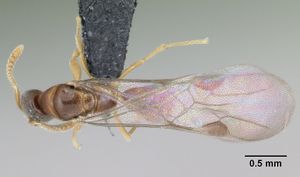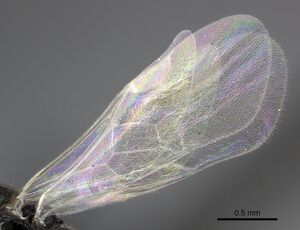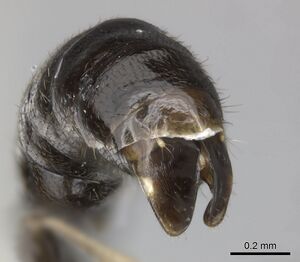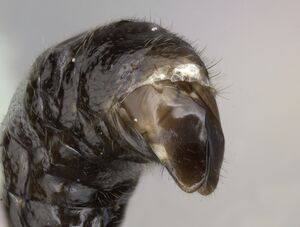Adetomyrma goblin
| Adetomyrma goblin | |
|---|---|

| |
| Scientific classification | |
| Kingdom: | Animalia |
| Phylum: | Arthropoda |
| Class: | Insecta |
| Order: | Hymenoptera |
| Family: | Formicidae |
| Subfamily: | Amblyoponinae |
| Tribe: | Amblyoponini |
| Genus: | Adetomyrma |
| Species: | A. goblin |
| Binomial name | |
| Adetomyrma goblin Yoshimura & Fisher, 2012 | |
A colony of this species was found in a rotten log and soil from rainforest that was transiting to montane forest. Other collections have come from litter samples and malaise traps from a variety of forest habitats.
Identification
Yoshimura and Fisher (2012) - The worker of Adetomyrma goblin is distinguished easily from other Adetomyrma species by the combination of a single shorter hair lateral to each longest hair on the anterior margin of the clypeus; the presence of a small denticle on the basal portion of the mandibular subapical tooth; and the small, lateral propodeal spiracle, which is not visible in dorsal view. The male of A. goblin is easily distinguished from those of other Adetomyrma species by its small black appearance and the clearly impressed notaulus on the mesoscutum. Our observations suggest that only A. goblin produces alate queens within the genus Adetomyrma.
Considerable variation was observed in the male characters of Adetomyrma goblin, including body size, wing color, width of flagellum, and hairs on abdominal surface. Some individuals were separately listed as the different morphospecies A. mgm02 in Yoshimura & Fisher (2012) based on the darker, smoked color of their wings. However, no other character is consistent or synchronous with this division, and moreover, A. mgm02 is not sympatrically distributed with the other A. goblin males. Therefore, here we regard all of those morphological differences as intraspecific variations in a single species, A. goblin.
Keys including this Species
Distribution
Latitudinal Distribution Pattern
Latitudinal Range: -12.27138889° to -23.20083333°.
| North Temperate |
North Subtropical |
Tropical | South Subtropical |
South Temperate |
- Source: AntMaps
Distribution based on Regional Taxon Lists
Malagasy Region: Madagascar (type locality).
Distribution based on AntMaps
Distribution based on AntWeb specimens
Check data from AntWeb
Countries Occupied
| Number of countries occupied by this species based on AntWiki Regional Taxon Lists. In general, fewer countries occupied indicates a narrower range, while more countries indicates a more widespread species. |

|
Estimated Abundance
| Relative abundance based on number of AntMaps records per species (this species within the purple bar). Fewer records (to the left) indicates a less abundant/encountered species while more records (to the right) indicates more abundant/encountered species. |

|
Biology
Castes
Worker
Images from AntWeb
   
| |
| Worker. Specimen code casent0056913. Photographer April Nobile, uploaded by California Academy of Sciences. | Owned by CAS, San Francisco, CA, USA. |
   
| |
| Paratype of Adetomyrma goblin. Worker. Specimen code casent0227983. Photographer Ryan Perry, uploaded by California Academy of Sciences. | Owned by CAS, San Francisco, CA, USA. |
   
| |
| Paratype of Adetomyrma goblin. Worker. Specimen code casent0227984. Photographer Ryan Perry, uploaded by California Academy of Sciences. | Owned by MHNG, Geneva, Switzerland. |
   
| |
| Paratype of Adetomyrma goblin. Worker. Specimen code casent0227989. Photographer Ryan Perry, uploaded by California Academy of Sciences. | Owned by NHMB, Basel, Switzerland. |
    
| |
| Paratype of Adetomyrma goblin. Worker. Specimen code casent0071148. Photographer Ryan Perry, uploaded by California Academy of Sciences. | Owned by NHMUK, London, UK. |
    
| |
| Paratype of Adetomyrma goblin. Worker. Specimen code casent0227982. Photographer Ryan Perry, uploaded by California Academy of Sciences. | Owned by CAS, San Francisco, CA, USA. |

| |
| . | |
Queen
Images from AntWeb
   
| |
| Queen (alate/dealate). Specimen code casent0007401. Photographer April Nobile, uploaded by California Academy of Sciences. | Owned by CAS, San Francisco, CA, USA. |
   
| |
| Queen (alate/dealate). Specimen code casent0056912. Photographer April Nobile, uploaded by California Academy of Sciences. | Owned by CAS, San Francisco, CA, USA. |
Male
Images from AntWeb
     
| |
| Male (alate). Specimen code casent0063980. Photographer Erin Prado, uploaded by California Academy of Sciences. | Owned by CAS, San Francisco, CA, USA. |
    
| |
| Male (alate). Specimen code casent0065512. Photographer Erin Prado, uploaded by California Academy of Sciences. | Owned by CAS, San Francisco, CA, USA. |
     
| |
| Male (alate). Specimen code casent0084070. Photographer April Nobile, uploaded by California Academy of Sciences. | Owned by CAS, San Francisco, CA, USA. |
   
| |
| Male (alate). Specimen code casent0138427. Photographer Dimby Raharinjanahary, uploaded by California Academy of Sciences. | Owned by CAS, San Francisco, CA, USA. |
      
| |
| Paratype of Adetomyrma goblin. Male (alate). Specimen code casent0191378. Photographer Ryan Perry, uploaded by California Academy of Sciences. | Owned by NHMUK, London, UK. |
      
| |
| Paratype of Adetomyrma goblin. Male (alate). Specimen code casent0227985. Photographer Ryan Perry, uploaded by California Academy of Sciences. | Owned by CAS, San Francisco, CA, USA. |
      
| |
| Paratype of Adetomyrma goblin. Male (alate). Specimen code casent0227986. Photographer Ryan Perry, uploaded by California Academy of Sciences. | Owned by CAS, San Francisco, CA, USA. |
      
| |
| Paratype of Adetomyrma goblin. Male (alate). Specimen code casent0227988. Photographer Ryan Perry, uploaded by California Academy of Sciences. | Owned by MHNG, Geneva, Switzerland. |
Nomenclature
The following information is derived from Barry Bolton's Online Catalogue of the Ants of the World.
- goblin. Adetomyrma goblin Yoshimura & Fisher, 2012b: 22, figs. 10, 17, 36, 45, 54, 62, 71, 77, 78, 83, 86, 88, 90, 93, 94 (w.q.m.) MADAGASCAR.
- Type-material: holotype worker, 5 paratype workers, 4 paratype males.
- Type-locality: holotype Madagascar: Fianarantsoa, Forêt de Vevembe, 66.6 km. 293° Farafangana, 22°47.46’S, 47°10.91’E, 600 m., 24.iv.2006, BLF14240, rainforest trans. to montane forest, ex rotten log, soil (B.L. Fisher, et al.); paratypes with same data.
- Type-depositories: CASC (holotype); BMNH, CASC, MCZC, MHNG, NHMB (paratypes).
- Distribution: Madagascar.
Unless otherwise noted the text for the remainder of this section is reported from the publication that includes the original description.
Description
Worker
Holotype. HL 0.58, HW 0.47, SL 0.39, HD 0.36, WL 0.77, PnW 0.33, MnW 0.19, PpW 0.27, PtW 0.27, CI 81.3, SI 83.2, MnI 40.9, PpI 141.1, PtI 100.7.
HL 0.46–0.6, HW 0.39–0.5, SL 0.28–0.39, HD 0.26–0.36, WL 0.39–0.83, PnW 0.26–0.35, MnW 0.16–0.21, PpW 0.22–0.3, PtW 0.21–0.3, CI 79.2–84.1, SI 68.2–81.9, MnI 42–46.8, PpI 124.4–142.3, PtI 91.4–107.8 (1 paratype and 9 individuals measured).
Head subquadrate in full-face view, longer than wide, sides almost parallel, posterior margin slightly concave. Clypeus short, principal surface deflected ventrally. Anterior margin of clypeus somewhat flattened on mid portion, furnished with a row of about 18 small, specialized, conical setae. Frontal carinae in full-face view short and low, expanded laterally as small frontal lobes covering no more than about 2× the length of the antennal insertions. Mandible subfalcate, without distinct basal and masticatory margins; inner margin with two apical teeth and four basal denticles; one small denticle on base of subapical tooth (second tooth from apex); out of four denticles, middle two denticles larger (longer) than the other two; third denticle from apical-most one largest; largest denticle sometimes divided into two adjacent denticles (observed in CASENT0127558, CASENT0438260). Palpal formula 3,3 (three maxillary and three labial). Antennal scape shorter than head length. Pedicel (second antennal segment) approximately equal to combined length of next three (third to fifth) antennal segments. Antenna gradually broadened from third segment and not forming a distinct club. Dorsal outline of mesosoma in lateral view somewhat rounded and continuous. Pronotum in dorsal view longer than broad, with convex sides. Mesonotum in dorsal view short, 2× as wide as long. Metapleuron fully fused with propodeum, division of two plates not distinguishable in lateral view. Dorsal face of propodeum slightly narrower than or as wide as pronotum, about 1.5× longer than wide, with subparallel sides converging slightly toward mesonotum. Propodeum in lateral view, dorsal margin about 2× to 2.5× length of declivitous margin, and rounding gently into the latter. Propodeal spiracle small, located distantly from propodeal dorsal margin in lateral view, not visible in dorsal view. Subpetiolar process distinctly developed, shaped like an irregular axe blade. Shallow and sparse punctures covering head, mesosoma, and abdomen; those on head dorsum denser than on the other parts.
Clypeus with two groups of hairs: mid clypeal hairs directed dorsally, and anterior clypeal hairs deflected anteriorly. Mid clypeal hairs consisting of one long hair and one or two shorter hairs around the long one. With head in full-face view, anterior clypeal hairs consisting of one pair of long hairs and single shorter hair laterally.
Queen
HL 0.57–0.61, HW 0.48–0.53, SL 0.37–0.41, EL 0.14–0.16, WL 0.9–0.99, MnW 0.39–0.49, PpW 0.35–0.41, PtW 0.28–0.34, CI 81.8–88.1, SI 71.2–79.6, EI 23.5–26.2, MnI 80–93.3, PpI 81.9–90.6, PtI 77.9–84.1 (6 individuals measured).
Winged. Head distinctly longer than wide in full-face view, sides slightly convex, posterior margin concave. Eye large and well-developed. Mid and lateral ocelli developed. Clypeal principal surface not strongly deflected. Anterior margin of clypeus shallowly concave, and furnished with a row of about 17 small, specialized, conical setae. Frontal lobes closely approximated. Mandible subfalcate, without distinct basal and masticatory margins: inner margin with two apical teeth and four long and distinct basal denticles; one small denticle on base of subapical tooth (second tooth from apex); out of four, middle two denticles larger (longer) than the other two; and third denticle from apical-most one largest. Antennal scape longer than 0.5x of the combined length of pedicel and flagellum. First flagellomere wider than long. Distal antennal segments not forming distinct club. With mesosoma in lateral view, its dorsum somewhat flattened; pronotum occupying whole anterior and about 0.25x of dorsal margins; mesonotum developed and occupying about 0.5x of mesosomal dorsal margin; metanotum developed and occupying small part of mesosomal dorsal margin; propodeum occupying remaining dorsal margin (less than 0.25x), and whole mesosomal posterior margin. With mesosoma in dorsal view, division between mesoscutum and mesoscutellum clear; axillae distinct; metanotum developed; and propodeum narrowed posteriorly. Propodeal spiracle in lateral view located far from propodeal declivity: distance from declivity margin longer than diameter of spiracle. Petiole similar to that in conspecific worker. With metasoma in dorsal view, with no width difference between posterior portion of petiole and anterior part of abdominal segment III.
Clypeus with two groups of hairs: mid clypeal hairs directed dorsally, and anterior clypeal hairs deflected anteriorly. Mid clypeal hairs consisting of one long hair and one to several shorter hairs around the long one. With head in full-face view, anterior clypeal hairs consisting of one pair of long hairs and a single shorter hair laterally. Hairs on body surface similar to those in conspecific workers.
Male
HL 0.41–0.75, HW 0.49–0.75, SL 0.09–0.96, EL 0.23–0.32, WL 0.79–1.28, MnW 0.42–0.75, CI 118.6–145.9, SI 17.3–18.7, EI 32.7–61.1, MnI 85.1–100.7 (5 individuals measured).
Eye well developed and prominent, posterior margin not exceeding posterior margin of mid ocellus in full-face view. Distance between lateral ocellus and eye long, 2x as long as diameter of lateral ocellus. Palpal formula 3,3 (three maxillary and three labial). Notaulus distinctly impressed on mesoscutum. Parapsidal line clearly impressed. Anterior margin of petiole longer than dorsal margin in lateral view. Subpetiolar process not developed or weakly developed, usually without hairs ventrally.
Left and right parameres not overlapping or narrowly overlapping on dorsal small part of basimere. No distinct projection or lobe present on posterodorsal portion of paramere. Basal ring not reduced: whole anterior margin of paramere in lateral view covered with this ring. Basal projection on cuspis clear but not extraordinarily well developed. Aedeagus in lateral view basal to mid portion relatively narrow; ventral projection relatively narrow; distal portion slightly narrowed after ventral projection; serrate denticles present on posteroventral margin; apical margin relatively dull, and without a small, broadly triangular projection on its ventral portion; posteroventral margin of ventral projection concave.
Hair on compound eyes short, less than 0.25x diameter of mid ocellus. Mesofemur in dorsal view, its anterior face covered with short appressed or subdecumbent hairs. Ventral margin of eye not edged with darker pigment or punctures. Body color a uniform black to blackish brown.
Type Material
Holotype. Worker: CASENT0227981, BLF14240, MADAGASCAR, Fianarantsoa, Forêt de Vevembe, 66.6 km 293° Farafangana, 22° 47.46´ S, 47° 10.91´ E, 600 m alt., rainforest, transition to montane forest, ex rotten log, soil, 24.iv.2006, B.L. Fisher et al. leg. California Academy of Sciences. Paratypes. 5 workers: CASENT0071148 The Natural History Museum, CASENT0227982 [CASC], CASENT0227983 Museum of Comparative Zoology, CASENT0227984 Musee d'Histoire Naturelle Genève, CASENT0227989 Naturhistorisches Museum, Basel, 4 males: CASENT0191378 [BMNH], CASENT0227985 [CASC], CASENT0227986 [MCZC], CASENT0227988 [MHNG], with same data as holotype.
Etymology
This species name refers to the goblin-like features of the new species: the males are small and black, and the workers possess long dentition on their masticatory margin. The species epithet is treated as a noun in apposition, and thus invariant.
Determination Clarifications
This new species corresponds to the following species codes used in previous studies: sp.: Saux et al. 2004; mg01: Yoshimura & Fisher 2012; mgm02: Yoshimura & Fisher 2012.
References
- Cantone S. 2017. Winged Ants, The Male, Dichotomous key to genera of winged male ants in the World, Behavioral ecology of mating flight (self-published).
- Cantone S. 2018. Winged Ants, The queen. Dichotomous key to genera of winged female ants in the World. The Wings of Ants: morphological and systematic relationships (self-published).
- Yoshimura, M. & Fisher, B.L. 2012. A revision of the Malagasy endemic genus Adetomyrma (Hymenoptera: Formicidae: Amblyoponinae). Zootaxa, 3341, 1-31.
References based on Global Ant Biodiversity Informatics
- Yoshimura M., B.L. Fisher. 2012. A revision of the Malagasy endemic genus Adetomyrma (Hymenoptera: Formicidae: Amblyoponinae). Zootaxa 3341: 1-31.

